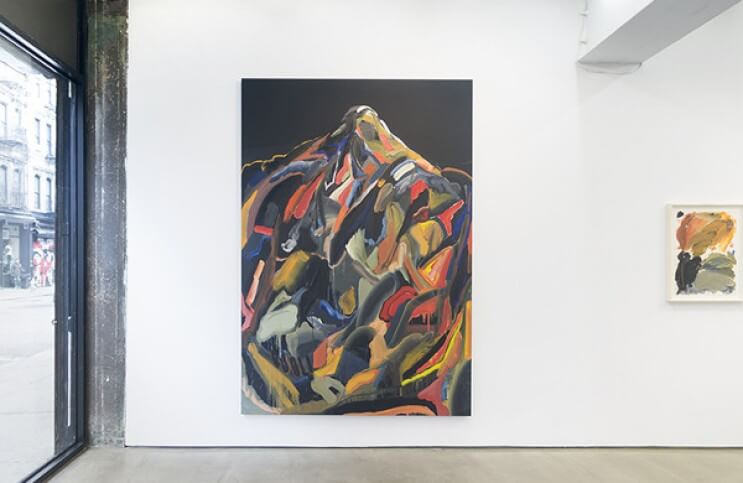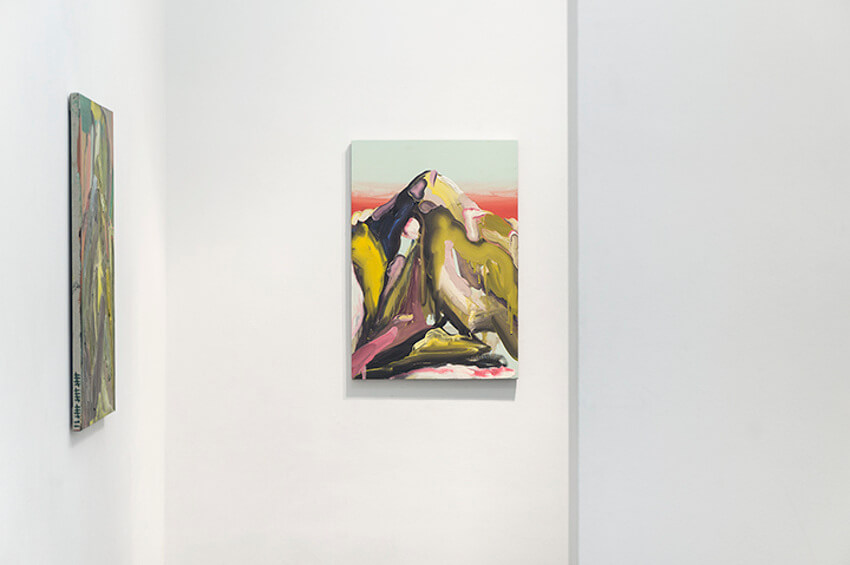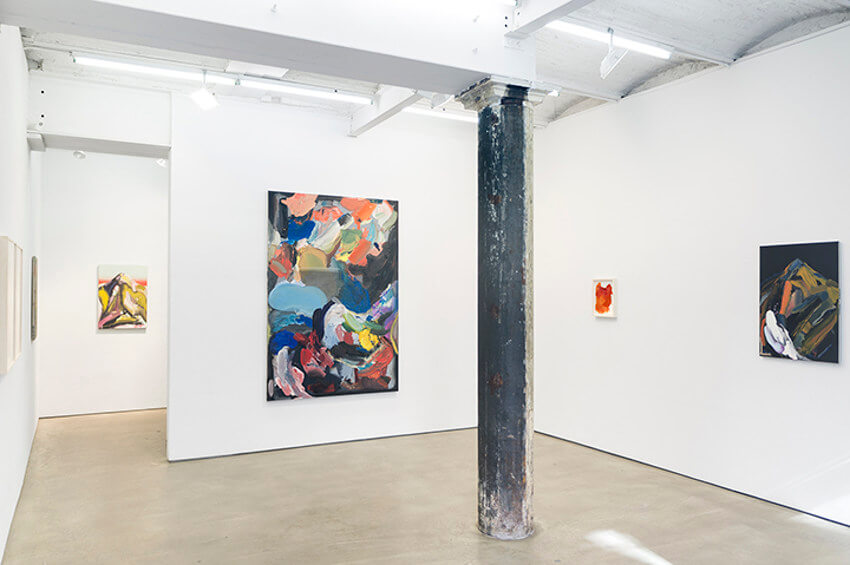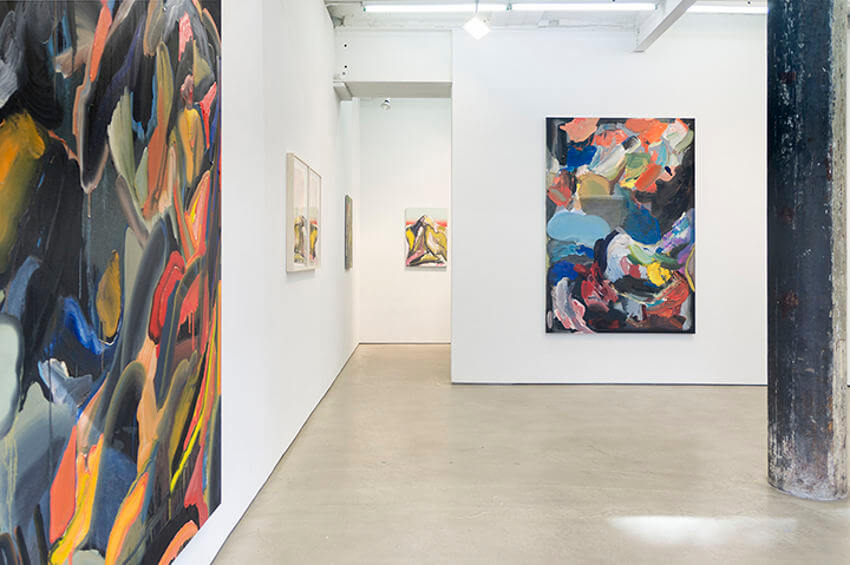
Andy Woll’s 150 Paintings of Mount Wilson
Western Wear, a solo exhibition of the work of Andy Woll on view at Denny Gallery in New York through 25 March, could be the basis for a masters course in art criticism. Objectively, it mostly features figurative paintings of mountains, interspersed with some purely abstract compositions. The mountain paintings are what Woll is largely known for. He grew up in Venice, California, and earned his BFA from Otis College of Art in Los Angeles. He has spent his entire life surrounded by the hills of the Angeles National Forest, which surround L.A. to the east and overlook the entire city. From childhood, Woll admired these hills. They became a symbolic feature of his visual landscape. Early in his painting career, he would abscond to one peak in particular—Mount Wilson—for a vantage point from which to paint the glittering metropolis below. Then he got the idea to reverse his perspective—to paint the mountain instead. He has since completed more than 150 paintings of Mount Wilson, examining it from different viewpoints, at different times of day, and highlighting its various different features. Those are the paintings that form the crux of the show at Denny Gallery. However, strewn among them, as mentioned, are several strictly abstract compositions. These abstract paintings mimic the formal qualities of the mountain paintings—especially their colors and their painterly, impasto qualities. The masters class begins there, with the question: “What is Andy Woll painting?” Is he painting Mount Wilson? Or is he painting color? Or texture? Or is the real subject of all of these paintings the paint?
Variations On a Theme
It might seem a bit OCD for a painter to return to the same subject over and over again. But most creative people know that the best thing that an artist can do to nurture productivity is set limitations on the imagination. If Woll woke up every day wondering what to paint, precious hours would be eaten up by discovery. By choosing to paint Mount Wilson repeatedly, he has constrained his creativity in order to be free. He has a place to start, and a definitive goal. Within this self-imposed limitation of a certain subject, he can explore other considerations, such as color, texture, gesture, light, form and composition. One way this freedom has manifested over the years is that it has spawned series within the main theme. For example, at one point he looked to his collection of science fiction novels for ideas about color, and for thoughts about symbolic references he could imbue within the images of the mountain.

Andy Woll - Western Wear, installation view, Denny Gallery, New York, 2018, photo courtesy Denny Gallery, New York
Part of the fun of looking at these Mount Wilson multiples is the chance to look for hidden mysteries in the paintings. One of his older mountain paintings, not in this show, titled Mt. Wilson (Orpheus V) (2017), seems to contain a subliminal figure within it; a crouched image, perhaps of the legendary Greek poet and musician Orpheus himself. Or maybe not. Perhaps the Orpheus reference has more to do with the color relationships that unfold between the abstract forms in the mountain side, which seem to vibrate, evoking the work of the Orphic Cubist pioneer Sonia Delaunay. Of course, these are pictures of mountains. To look deeper at them than that might be wishful thinking. But their aesthetic range invites speculation. Even though they are variations on a theme, I cannot help but peel back the layers of meaning and symbolism contained within them—a process that leaves me wondering, in fact, what exactly the real theme of the work truly is.

Andy Woll - Western Wear, installation view, Denny Gallery, New York, 2018, photo courtesy Denny Gallery, New York
The Purpose of Painting
In a recent interview with Maxwell Williams for Cultured Magazine, Woll had this to say about his relationship with figuration and abstraction: “I like abstraction; I like representation. I don’t really feel the strongest division between those two things. If the painting was just the bottom two thirds, it would be—I don’t know. The representation part gives it a purpose.” As someone who writes about abstract art for a living, I was taken aback by the phrase, “The Representation part gives it purpose.” I wondered, is that intended to suggest that only representational art has a purpose? I recall Donald Judd saying once that art is useless—since he meant all art, that actually sounds more fair than what Woll said. Upon further reflection, however, I realized that Woll is not talking about the purpose that his work has to viewers, exhibitors, or collectors. We each have our own use in mind for every work of art we encounter. What Woll is talking about, rather, is what purpose his work holds for him, personally, as the one making it.

Andy Woll - Western Wear, installation view, Denny Gallery, New York, 2018, photo courtesy Denny Gallery, New York
It is as though Woll was expressing his need to defend his desire to push paint around on a surface; as if paint culminating in an image of something recognizable defines the action as worth doing, but if all he manages is something unrecognizable, he has wasted his time. In Western Wear, his current show, there are multiple paintings on view that suggest that he is ready to openly defy his previous comment. These abstract paintings have no recognizable imagery. They do, however, have a recognizable palette, derived from the mountains Woll has painted. They have recognizable textures, showing deep grooves, rising peeks, and sweeping valleys of their own, where light bounces and shines, and shadows beckon. These are not paintings of mountains, to be sure. In my opinion, these are paintings of paint. They are celebrations of the medium. When I look at them, I think, “look at that paint...look how tactile it is.” I smell the paint; imagine how it would feel to run my fingers over it. With these works, Woll has conveyed that art does not need a purpose; it has its own purpose, and its own reason for existing, aside from why it was made.
Featured image: Andy Woll - Western Wear, installation view, Denny Gallery, New York, 2018, photo courtesy Denny Gallery, New York
By Phillip Barcio






